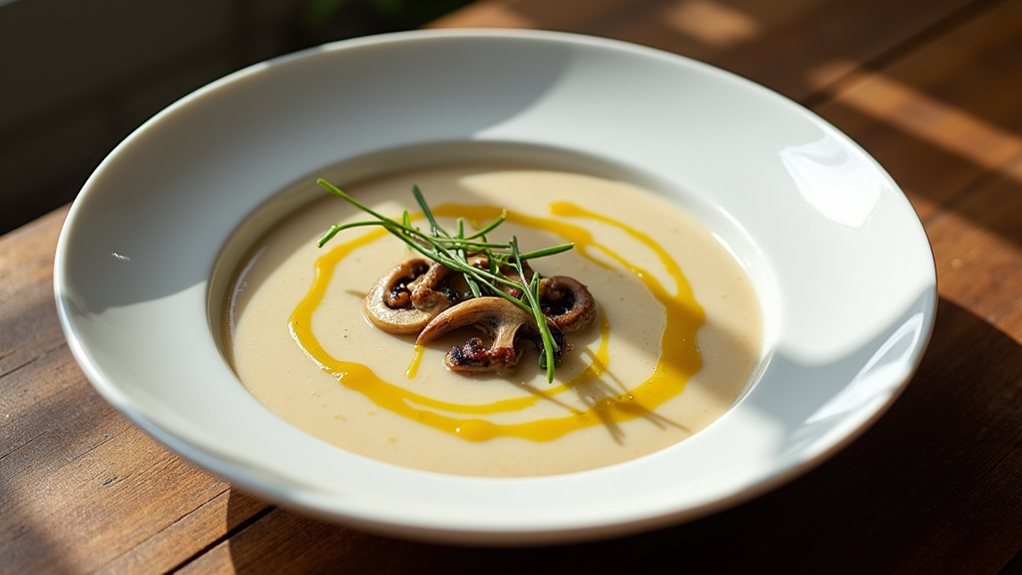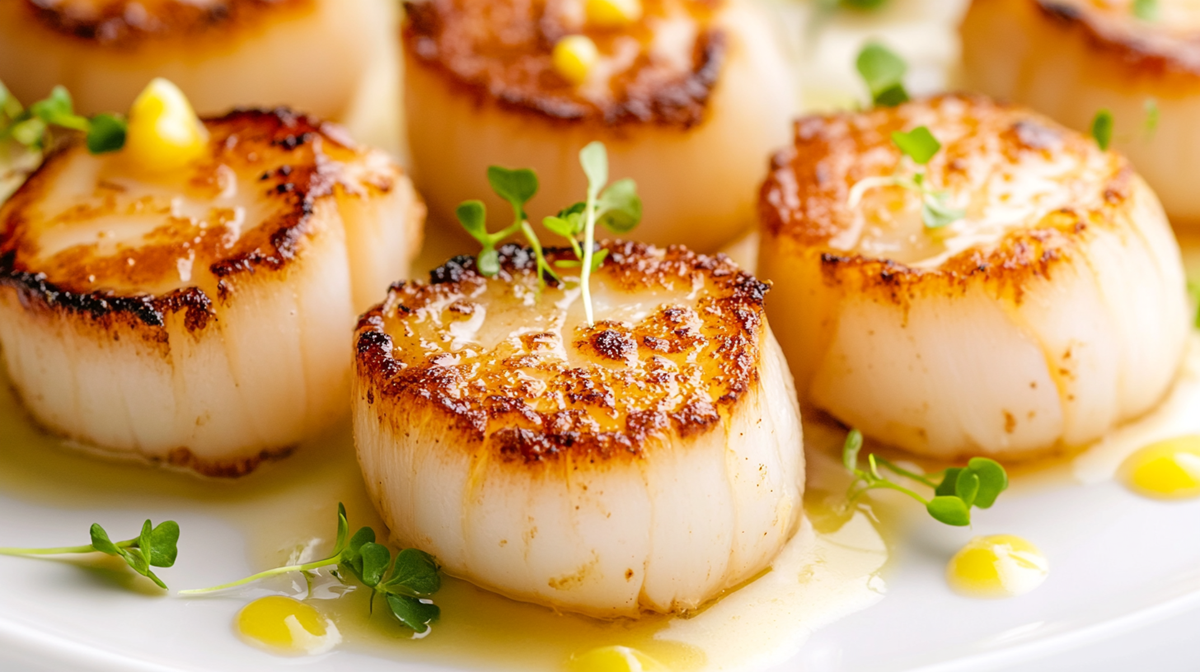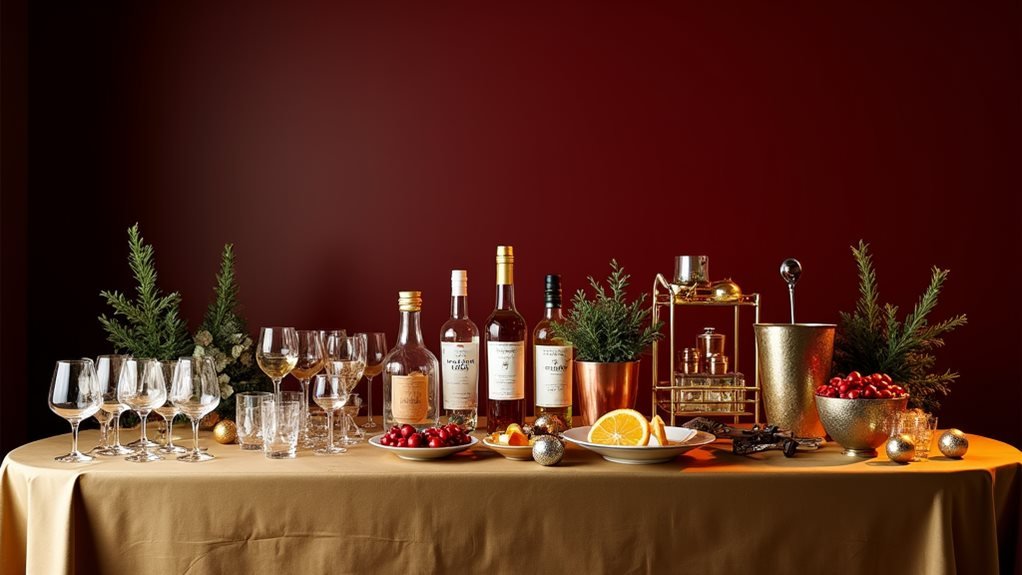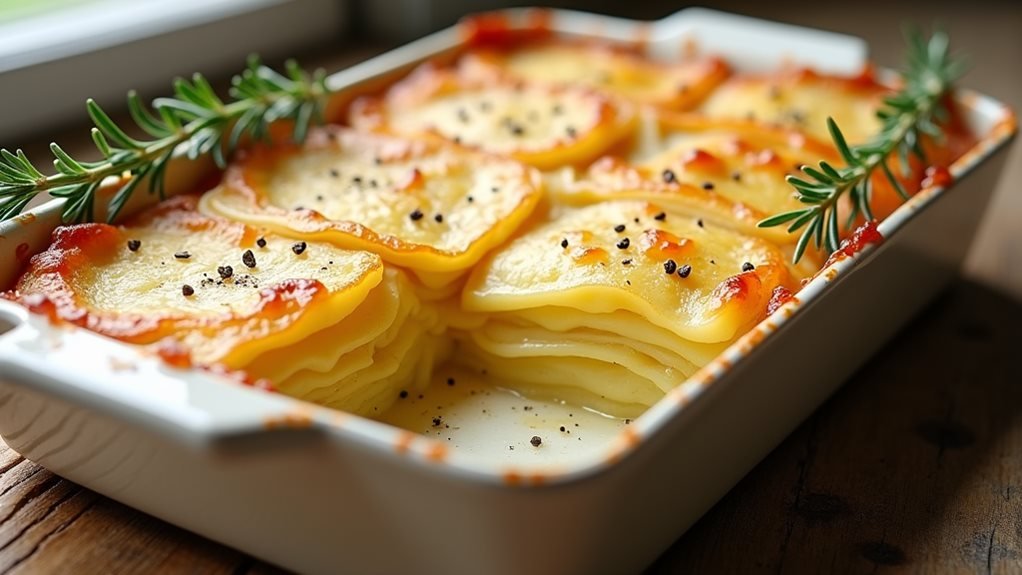Gordon Ramsay's Michelin-starred restaurants showcase his culinary expertise through a refined selection of appetizers. From the expertly prepared Beef Tartare to the luxuriant Wild Mushroom Velouté, each dish represents the pinnacle of fine dining. These five starters don't just set the stage for the main course; they've become iconic representations of Ramsay's distinctive style. Let's investigate how these masterful creations earned their place on some of the world's most prestigious menus.
Beef Tartare With Herb Crème Fraîche
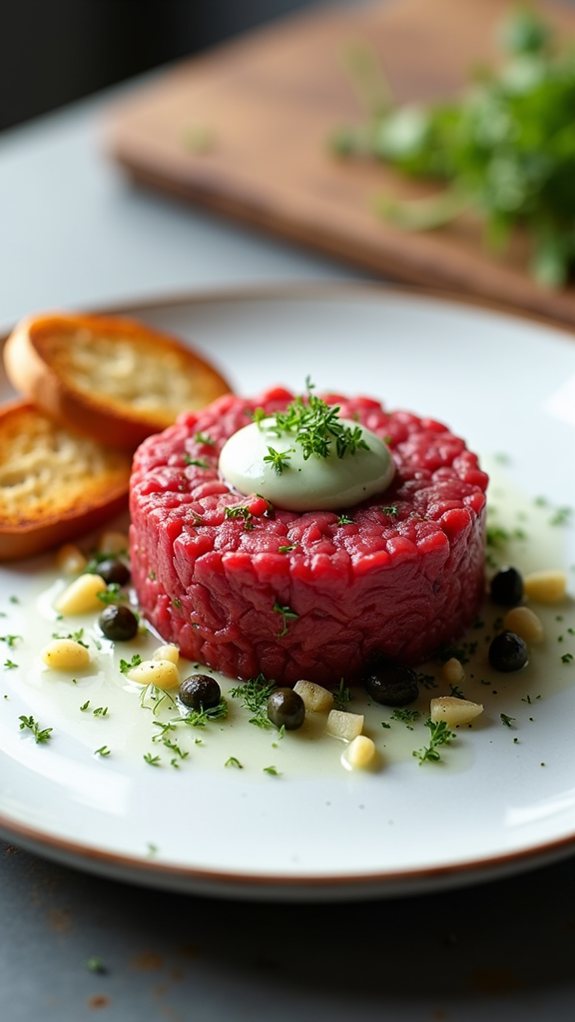
Beef tartare, a classic French dish that showcases the pure, rich flavor of raw beef, gets a sophisticated upgrade with the addition of herb-infused crème fraîche. This elegant appetizer, prominently featured in Gordon Ramsay's restaurants, combines carefully hand-chopped premium beef with traditional accompaniments that improve rather than overwhelm the meat's natural taste.
While some might feel intimidated by preparing raw beef at home, this dish is actually straightforward to execute when you follow proper food safety guidelines and use high-quality ingredients. The key lies in selecting fresh, top-grade beef tenderloin and maintaining a clean work environment throughout the preparation process.
Much like his famous Beef Wellington preparation, this dish requires meticulous attention to detail and premium ingredients to achieve restaurant-quality results.
- 8 oz fresh beef tenderloin, trimmed
- 2 tablespoons shallots, finely minced
- 1 tablespoon capers, drained and chopped
- 1 tablespoon Dijon mustard
- 2 teaspoons Worcestershire sauce
- 1/2 cup crème fraîche
- 2 tablespoons fresh chives, finely chopped
- 2 tablespoons fresh parsley, finely chopped
- 1 tablespoon fresh tarragon, chopped
- Salt and freshly ground black pepper
- Toasted baguette slices for serving
Using a sharp knife, carefully hand-chop the beef into small, uniform pieces – avoid using a food processor as it will turn the meat mushy. In a mixing bowl, combine the chopped beef with minced shallots, capers, Dijon mustard, and Worcestershire sauce.
Meanwhile, prepare the herb crème fraîche by mixing the crème fraîche with chives, parsley, and tarragon. Season both the beef mixture and herb crème fraîche with salt and pepper to taste. Serve immediately, with the beef tartare shaped into a neat mound and topped with a generous dollop of the herb crème fraîche, accompanied by toasted baguette slices.
For best results, keep all ingredients well-chilled until ready to serve. When selecting beef, inform your butcher that you're making tartare so they can provide you with the freshest, highest-quality cut.
Consider freezing the beef for 15 minutes before chopping – this will make it easier to achieve clean, precise cuts. Always serve the tartare immediately after preparation and never save leftovers, as raw beef should be consumed within 2 hours of preparation at room temperature.
Pan-Seared Scallop Ceviche With Citrus
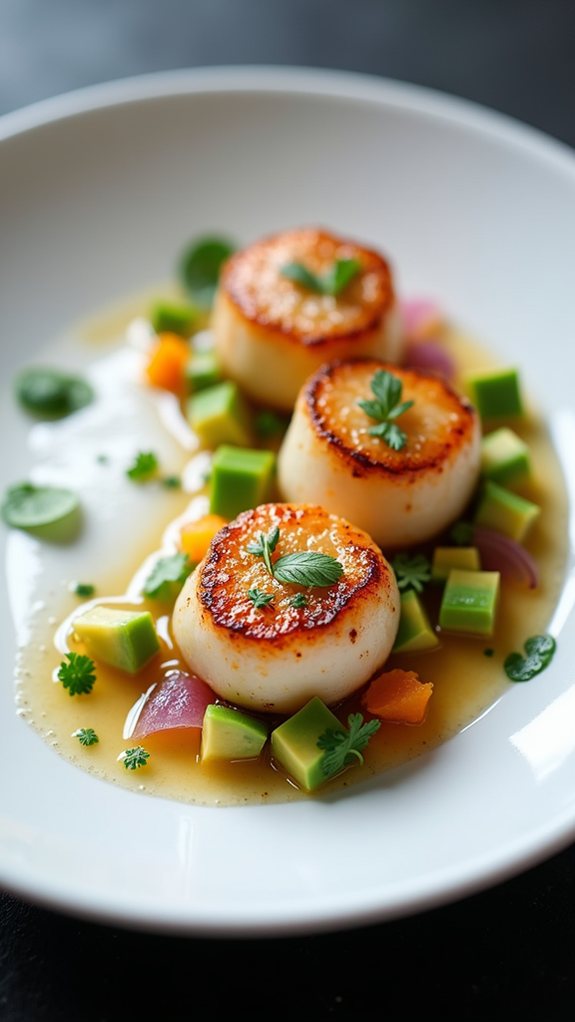
Pan-seared scallops meet the bright, acidic flavors of traditional ceviche in this elegant appetizer that's become a staple at Gordon Ramsay's restaurants. The dish combines the classic South American preparation method with a modern twist, creating a harmonious balance between cooked and raw elements that showcase the natural sweetness of fresh sea scallops.
While traditional ceviche relies solely on citrus juice to "cook" the seafood, this version partially sears the scallops to create a caramelized exterior while maintaining a tender center. The citrus marinade adds layers of complexity without overwhelming the delicate flavor of the scallops, making it an impressive yet approachable initial course.
- 12 large sea scallops, patted dry
- 2 limes, juiced
- 1 lemon, juiced
- 1 orange, juiced
- 1 small red onion, finely diced
- 2 tablespoons olive oil
- 1 jalapeño pepper, seeded and minced
- 1/4 cup fresh cilantro, chopped
- 1 ripe avocado, diced
- Salt and black pepper to taste
- Micro greens for garnish
Heat a heavy-bottomed skillet over high heat until very hot. Season scallops with salt and pepper, then sear them in olive oil for 1-2 minutes on each side until golden brown but still rare in the center. Remove from heat and slice each scallop into three thin rounds.
Combine citrus juices in a bowl and add the sliced scallops, red onion, jalapeño, and cilantro. Let marinate for 5 minutes, then gently fold in the diced avocado. Arrange on plates and garnish with micro greens.
For best results, use "dry" scallops (those without chemical additives) and confirm they're completely dry before searing to achieve proper caramelization. The marination time is vital – five minutes is enough to improve flavors without over-cooking the scallops in the citrus juice.
If you can't find fresh scallops, don't attempt this dish with frozen ones, as the texture and flavor won't be the same. Serve immediately after the brief marination to maintain the best texture contrast between the seared exterior and citrus-kissed interior. This elegant appetizer pairs beautifully with pan fried halibut for an impressive seafood-focused meal.
Lobster Ravioli in Shellfish Bisque
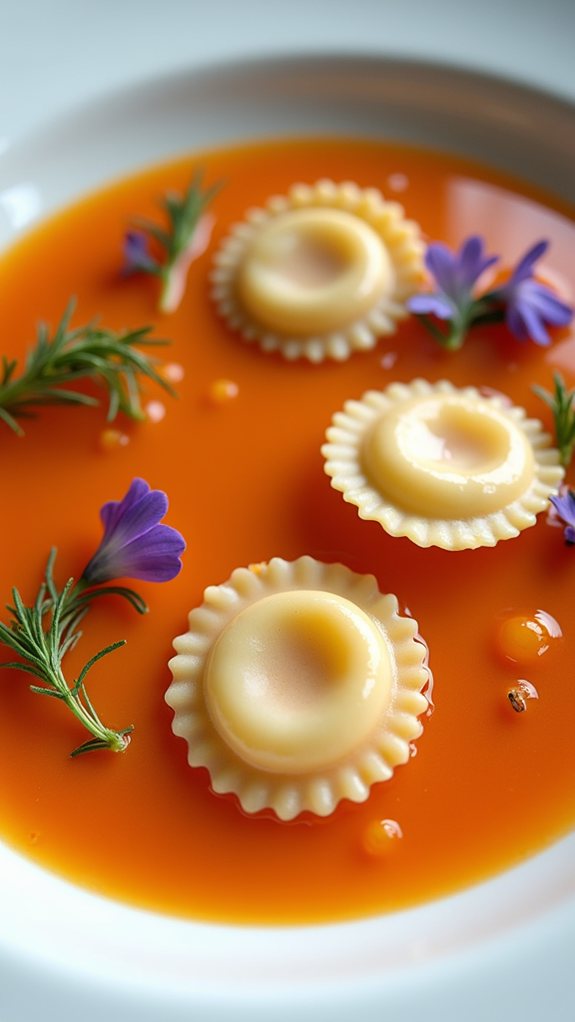
Creating restaurant-quality lobster ravioli at home might seem intimidating, but this elegant dish is entirely manageable when broken down into simple steps. The combination of delicate pasta parcels filled with sweet lobster meat, swimming in a rich shellfish bisque, creates a starter that's both impressive and deeply satisfying.
The key to this dish lies in extracting maximum flavor from the shellfish. While lobster is the star, the supporting cast of shrimp shells and aromatic vegetables in the bisque provides depth and complexity. The pasta dough needs to be rolled thin enough to be delicate yet strong enough to hold the filling – a balance that comes with practice.
Like the premium cocktail pairings at Gordon Ramsay's Kitchen, this dish offers a sophisticated yet approachable dining experience.
Ingredients:
- 2 whole lobsters (1½ pounds each)
- 1 pound shrimp shells
- 3 cups all-purpose flour
- 4 large eggs
- 2 shallots, minced
- 3 garlic cloves, crushed
- 2 carrots, diced
- 2 celery stalks, diced
- 2 tablespoons tomato paste
- 1 cup heavy cream
- 1 cup white wine
- 4 cups fish stock
- Fresh herbs (thyme, parsley)
- Salt and white pepper
- Olive oil
Begin by cooking the lobsters in boiling water until just done, then shock in ice water. Remove meat and reserve shells.
Make the pasta dough by creating a well with flour, adding eggs, and kneading until smooth. For the bisque, sauté vegetables with lobster and shrimp shells, add tomato paste, deglaze with wine, add stock, and simmer. Strain, add cream, and reduce.
Roll pasta dough thin, fill with chopped lobster meat mixed with herbs and seasonings, form ravioli, and cook in salted water until they float. Serve in hot bisque.
When making the ravioli, make sure all air is pressed out before sealing to prevent them from bursting while cooking. The pasta dough can be made a day ahead and refrigerated, but bring it to room temperature before rolling.
If fresh lobsters aren't available, high-quality frozen lobster meat can be substituted, though you'll need to purchase additional shells for the bisque.
Foie Gras Torchon With Brioche
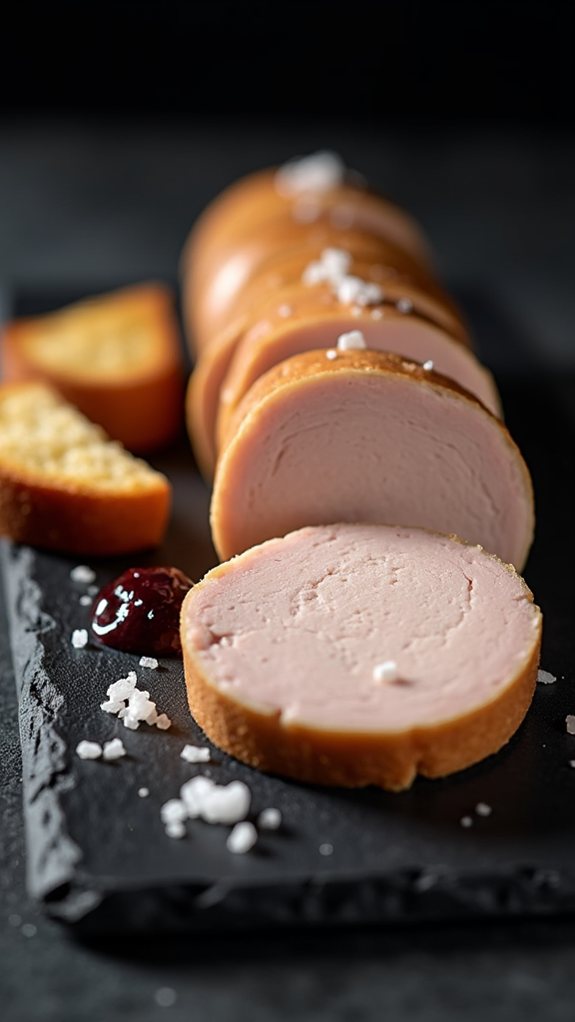
Foie gras torchon is one of those classical French dishes that seems intimidating but is actually quite straightforward to prepare. The term "torchon" means "dish towel" in French, referring to the traditional method of wrapping and poaching the foie gras in a kitchen towel to create a cylindrical shape.
While this luxurious appetizer is a staple in high-end restaurants, making it at home allows you to control the seasoning and achieve the perfect texture. The key is to properly clean and devein the foie gras before seasoning, and then carefully control the temperature during the cooking process to achieve that signature buttery smoothness.
- 1 pound grade-A fresh foie gras
- 2 tablespoons Sauternes wine
- 2 teaspoons kosher salt
- 1 teaspoon white pepper
- ¼ teaspoon sugar
- ¼ teaspoon pink curing salt (optional)
- 8 slices brioche bread
- 2 tablespoons unsalted butter
- Fig jam for serving
- Flaky sea salt for garnish
Clean the foie gras by carefully removing any visible veins and membrane, then cut into large chunks. Mix with Sauternes, salt, pepper, and sugar, then refrigerate for 24 hours.
Roll the seasoned foie gras tightly in plastic wrap to form a cylinder, then wrap in a kitchen towel. Poach in 160°F water for 30 minutes, then immediately transfer to an ice bath. Once cooled, refrigerate for at least 24 hours before serving.
To serve, remove from refrigerator 20 minutes prior to slicing, toast the brioche until golden, and garnish with fig jam and sea salt.
For best results, use a sharp knife dipped in hot water between each slice of the torchon to achieve clean cuts. The foie gras can be prepared up to five days in advance and kept refrigerated.
If pink curing salt is used, the torchon will maintain a rosy color and have a slightly longer shelf life. Always serve the torchon slightly chilled but not cold, as this allows the natural flavors to develop fully on the palate.
Wild Mushroom Velouté With Truffle Oil
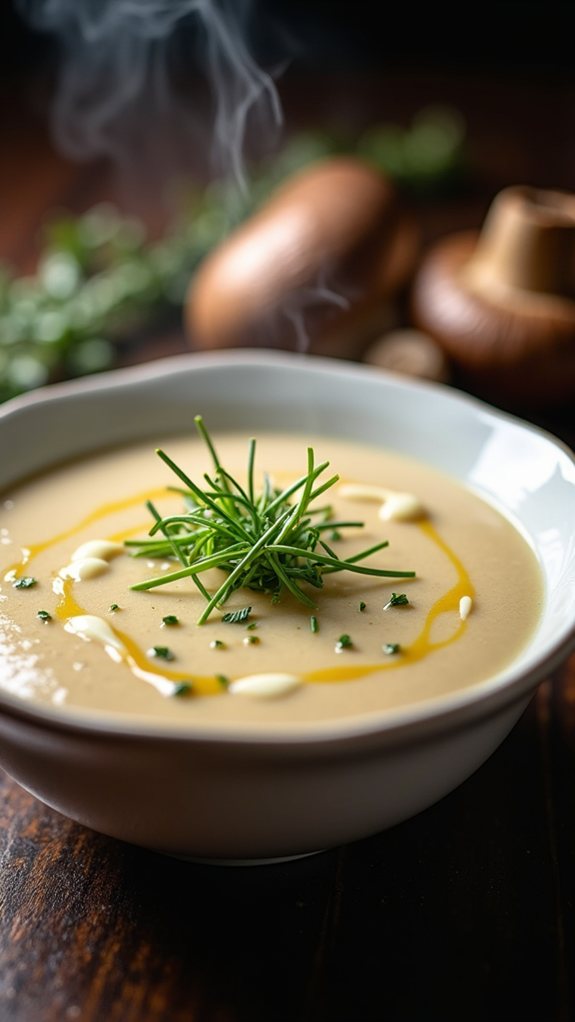
Velouté, one of the five mother sauces in French cuisine, gets an elegant enhancement in this wild mushroom version that's a staple at Gordon Ramsay's restaurants. This velvety soup combines earthy wild mushrooms with a rich, cream-based sauce, finished with a drizzle of aromatic truffle oil that raises it from simple to sublime.
While traditional velouté uses chicken or veal stock, this mushroom variation creates its own deeply flavored stock from a mixture of wild mushrooms. The combination of different mushroom varieties – like porcini, shiitake, and cremini – builds layers of complex flavors that make this soup distinctively luxurious yet comforting.
- 1 pound mixed wild mushrooms
- 4 tablespoons unsalted butter
- 1 medium onion, finely chopped
- 2 cloves garlic, minced
- 1/3 cup all-purpose flour
- 6 cups vegetable stock
- 1/2 cup heavy cream
- 2 sprigs fresh thyme
- 2 bay leaves
- 2 tablespoons truffle oil
- Salt and white pepper to taste
- Chives for garnish
Clean and roughly chop the mushrooms, then sauté them in butter until golden brown. Add onions and garlic, cooking until softened. Sprinkle flour over the mixture and cook for 2 minutes, stirring constantly. Gradually add the stock while whisking to prevent lumps, then add thyme and bay leaves.
Simmer for 25 minutes, remove herbs, and blend until smooth. Stir in cream, season with salt and white pepper, and finish with a drizzle of truffle oil and chopped chives.
For the best results, use fresh mushrooms rather than dried ones, though dried porcini can be added for extra intensity. The soup should be silky smooth, so blend thoroughly and strain if needed.
Be cautious with the truffle oil – it's potent and should be added just before serving. The soup can be made ahead and reheated gently, but add the cream and truffle oil only when ready to serve.
